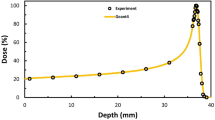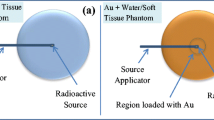Abstract
Gold nanoparticles are promising radiosensitizers for proton radiotherapy. However, the physical mechanisms of gold nanoparticles radiosensitization remain unclear. In the present study, the Geant4 toolkit was used to estimate by the Monte-Carlo simulation the changes (1) in the contribution of primary and secondary particles to the absorbed dose, (2) in the dose-averaged linear energy transfer, and (3) in the relative biological effectiveness of a 150 MeV proton beam caused by the addition of 50 mg/mL of gold nanoparticles to the irradiated water phantom. In the presence of gold nanoparticles no significant changes in the absorbed dose and the Bragg peak position were found, at the same time a redistribution of the contribution of secondary particles to the absorbed dose was recorded. An increase in the contributions from protons (~16%), recoil nuclei (~58%), α-particles (~400%), deuterons (~900%), tritons (~3000%), and photons (~7000%) was observed ~10 mm beyond the Bragg peak. The contribution of the secondary electrons decreased by ~35%. This redistribution led to ~5-fold increase in the dose-averaged linear energy transfer at the distal edge of the Bragg curve; this, in turn, may cause the ~1.4−2.2-fold increase in the relative biological effectiveness within this region. Thus, it is critically important to take into account the presence of gold nanoparticles when dosimetric planning proton radiotherapy in order to avoid unwanted damage to the normal tissues around the tumor.





Similar content being viewed by others
REFERENCES
D. Schulz-Ertner and H. Tsujii, J. Clin. Oncol. 25, 953 (2007).
T. Mitin and A. L. Zietman, J. Clin. Oncol. 32, 2855 (2014).
D. I. Yurkov, S. V. Syromukov, V. V. Tatarskiy, et al., Acta Naturae 11, 99 (2019).
B. S. Sorensen, J. Overgaard, and N. Bassler, Acta Oncol. 50, 757 (2011).
W. D. Newhauser and R. Zhang, Phys. Med. Biol. 60, R155 (2015).
R. Mohan and D. Grosshans. Adv. Drug Deliv. Rev. 109, 26 (2017).
X. Tian, K. Liu, Y. Hou, et al., Mol. Clin. Oncol. 8, 15 (2018).
Particle Therapy Co-Operative Group, Particle Therapy Facilities in Clinical Operation. https://www.ptcog.ch/index.php/facilities-in-operation. Cited February 24, 2020.
S. Lacombe, E. Porcel, and E. Scifoni, Cancer Nanotechnol. 8, 9 (2017).
Y. Liu, P. Zhang, F. Li, et al., Theranostics 8, 1824 (2018).
D. Peukert, I. Kempson, M. Douglass, and E. Bezak, Phys. Med. 47, 121 (2018).
J. K. Kim, S. J. Seo, K. H. Kim, et al., Nanotechnology 21, 425102 (2010).
J. C. Polf, L. F. Bronk, W. H. Driessen, et al., Appl. Phys. Lett. 98, 193702 (2011).
J. K. Kim, S. J. Seo, H. T. Kim, et al., Phys. Med. Biol. 57, 8309 (2012).
J. C. Jeynes, M. J. Merchant, A. Spindler, et al., Phys. Med. Biol. 59, 6431 (2014).
S. Li, S. Penninckx, L. Karmani, et al., Nanotechnology 27, 455101 (2016).
S. Li, S. Bouchy, S. Penninckx, et al., Nanomedicine 14, 317 (2019).
C. Walzlein, E. Scifoni, M. Kramer, and M. Durante, Phys. Med. Biol. 59, 1441 (2014).
S. McKinnon, S. Guatelli, S. Incerti, et al., Phys. Med. 32, 1584 (2016).
R. Ahmad, G. Royle, A. Lourenco, et al., Phys. Med. Biol. 61, 4537 (2016).
J. Cho, C. Gonzalez-Lepera, N. Manohar, et al., Phys. Med. Biol. 61, 2562 (2016).
H. N. Tran, M. Karamitros, V. N. Ivanchenko, et al., Nucl. Instr. Meth. Phys. Res. B 373, 126 (2016).
J. Gao and Y. Zheng, Int. J. Cancer Ther. Oncol. 2, 02025 (2014).
A. C. Heuskin, B. Gallez, O. Feron, et al., Med. Phys. 44, 4299 (2017).
A. V. Verkhovtsev, A. V. Korol, and A. V. Solov’yov, J. Phys. Chem. C 119, 11000 (2014).
H. Jiang, B. Wang, X. G. Xu, et al., Phys. Med. Biol. 50, 4337 (2005).
P. J. Taddei, D. Mirkovic, J. D. Fontenot, et al., Phys. Med. Biol. 54, 2259 (2009).
J. Allison, K. Amako, J. Apostolakis, et al., Nucl. Instr. Meth. Phys. Res. A 835, 186 (2016).
W. Ngwa, G. M. Makrigiorgos, and R. I. Berbeco, Phys. Med. Biol. 55, 6533 (2010).
M. Hossain and M. Su, J. Phys. Chem. C 116, 23047 (2012).
F. Guan, C. Peeler, L. Bronk, et al., Med. Phys. 42, 6234 (2015).
A. V. Belousov, R. B. Bahtiosin, M. A. Kolyvanova, et al., Med. Radiol. Radiat. Safety 64, 5 (2019).
G. Kraft, Prog. Part. Nucl. Phys. 45, S473 (2000).
G. Dollinger, Nanotechnology 22, 248001 (2011).
C. Le Sech, K. Kobayashi, N. Usami, et al., Nanotechnology 23, 078001 (2012).
E. Alizadeh, T. M. Orlando, and L. Sanche, Annu. Rev. Phys. Chem. 66, 379 (2014).
S. Brousmiche, K. Souris, J. O. de Xivry, et al., Phys. Med. Biol. 62, 8226 (2017).
M. Goitein and G. T. Chen, Med. Phys. 10, 831 (1983).
F. Tommasino, M. Rovituso, E. Bortoli, et al., Physica Medica 58, 99 (2019).
ACKNOWLEDGMENTS
The study was performed using the equipment of the Center for Collective Use of Ultra-High Performance Computing Resources of Moscow State University.
Funding
This study was supported by the Nuclear Medicine Development Program of JSC Science and Innovations of the Rosatom State Corporation (project no. AAAA-A19-119122590084-4).
Author information
Authors and Affiliations
Corresponding author
Ethics declarations
The authors declare no conflicts of interest. This work does not contain description of any studies using humans and animals as objects.
Additional information
Translated by M. Batrukova
Abbreviations: LET, linear energy transfer; GNP, gold nanoparticles; RBE, relative biological effectiveness.
Rights and permissions
About this article
Cite this article
Belousov, A.V., Morozov, V.N., Krusanov, G.A. et al. The Change in the Linear Energy Transfer of a Clinical Proton Beam in the Presence of Gold Nanoparticles. BIOPHYSICS 65, 541–547 (2020). https://doi.org/10.1134/S0006350920040053
Received:
Revised:
Accepted:
Published:
Issue Date:
DOI: https://doi.org/10.1134/S0006350920040053




